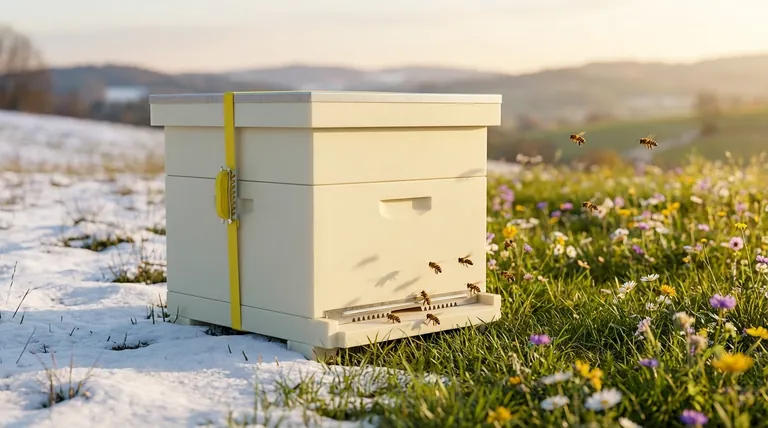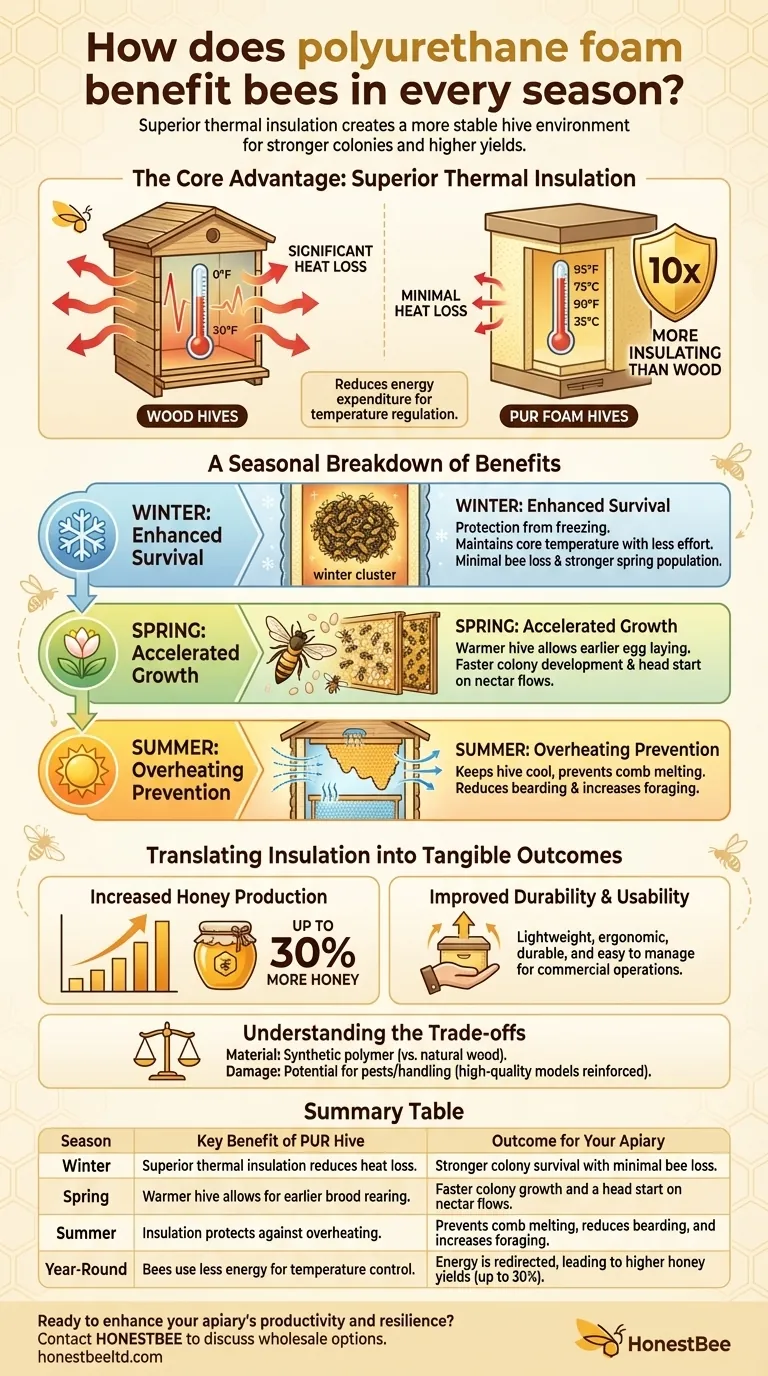In every season, polyurethane foam offers significant thermal insulation that creates a more stable internal hive environment for honeybees. This protects the colony from temperature extremes, reducing stress and allowing the bees to redirect energy from temperature control to crucial tasks like brood rearing and honey production.
The core advantage of polyurethane foam hives lies in their superior insulation. By drastically reducing the energy bees must expend to regulate their colony's temperature, these hives enable stronger winter survival, faster spring growth, and ultimately, higher honey yields.

The Core Advantage: Superior Thermal Insulation
A bee colony's primary struggle is maintaining a stable internal temperature against the outside weather. This effort consumes an enormous amount of energy, which comes directly from the honey they produce and store.
Why Insulation Matters for a Bee Colony
Bees must maintain their central brood nest at approximately 95°F (35°C) to raise young. In winter, they form a "winter cluster," shivering their flight muscles to generate heat and survive, consuming stored honey as fuel.
Superior insulation reduces the amount of heat that escapes the hive. This lessens the colony's workload, preserving both their energy and their food stores.
A Direct Comparison: PUR vs. Wood
Polyurethane foam (PUR) is a dramatically more effective insulator than traditional pine. The material is often cited as being ten times more insulating than wood, creating a powerful thermal barrier.
This difference means that a colony in a PUR hive uses significantly less energy to stay warm in the winter and cool in the summer compared to one in a standard wooden hive.
A Seasonal Breakdown of Benefits
The thermal stability provided by polyurethane foam translates into distinct advantages that compound across the beekeeping year.
Winter: Enhanced Survival
The primary benefit in winter is protection from freezing. Excellent insulation means the winter cluster can maintain its core temperature with far less effort, leading to minimal bee loss and a stronger population emerging in the spring.
Spring: Accelerated Growth
Because the hive environment remains warmer, the queen can begin laying eggs earlier in the season. Bee families in PUR hives start developing earlier and reach their full strength more quickly, giving them a head start on the first nectar flows.
Summer: Overheating Prevention
The same insulation that keeps a hive warm in winter also keeps it cool in summer. This protects the colony from overheating, prevents the wax comb from melting, and reduces the need for "bearding"—where large numbers of bees cluster outside the hive to cool off instead of foraging.
Translating Insulation into Tangible Outcomes
The energy saved through better insulation directly impacts the hive's productivity and the beekeeper's experience.
Increased Honey Production
With less energy diverted to heating or cooling the hive, bees can focus more effort on raising brood and foraging for nectar. This efficiency boost has been shown to result in up to 30% more honey compared to colonies in less insulated hives.
Improved Durability and Usability
Modern PUR hives are designed for beekeeper efficiency. They are lightweight, making them easier to lift and manage, which is a major advantage for both hobbyists and commercial operators with nomadic apiaries.
Many are also built with reinforced corners and edges, allowing the use of hive tools without damaging the softer foam material.
Understanding the Trade-offs
While the thermal benefits are clear, a trusted advisor must consider all angles. No material is perfect for every situation.
Material and Environmental Profile
Polyurethane is a plastic polymer, not a natural material like wood. Beekeepers focused on "all-natural" practices may prefer traditional materials. You must also consider the long-term environmental impact of foam versus the renewable nature of wood.
Potential for Damage
While durable, foam can be damaged by pests like wax moths or mice if the hive is not properly secured and maintained. It can also be more susceptible to damage from improper handling if not reinforced, though high-quality models account for this.
Making the Right Choice for Your Apiary
Your decision on hive material should be guided by your specific goals, climate, and management style.
- If your primary focus is maximizing winter survival and spring buildup: The superior insulation of polyurethane foam provides a decisive advantage, especially in colder climates.
- If your primary focus is maximizing honey yield: The energy savings and faster colony development in PUR hives directly translate to higher productivity and a better return on your efforts.
- If your primary focus is operational efficiency: The lightweight, ergonomic, and standardized nature of modern PUR hives makes them easier to manage, move, and scale.
Ultimately, polyurethane foam helps create a more forgiving and stable environment, allowing your bees to dedicate their remarkable energy to what they do best.
Summary Table:
| Season | Key Benefit of PUR Hive | Outcome for Your Apiary |
|---|---|---|
| Winter | Superior thermal insulation reduces heat loss. | Stronger colony survival with minimal bee loss. |
| Spring | Warmer hive allows for earlier brood rearing. | Faster colony growth and a head start on nectar flows. |
| Summer | Insulation protects against overheating. | Prevents comb melting, reduces bearding, and increases foraging. |
| Year-Round | Bees use less energy for temperature control. | Energy is redirected, leading to higher honey yields (up to 30%). |
Ready to enhance your apiary's productivity and resilience?
HONESTBEE supplies durable, lightweight polyurethane foam hives and beekeeping equipment to commercial apiaries and distributors. Our superior insulation technology helps your bees thrive in all seasons, leading to stronger colonies and significantly higher honey production.
Contact HONESTBEE today to discuss wholesale options and how our equipment can benefit your operation.
Visual Guide

Related Products
- Professional Galvanized Hive Strap with Secure Locking Buckle for Beekeeping
- Professional Drop-Style Hive Handles for Beekeeping
- HONESTBEE Professional Hive Top Bee Feeder Feeding Solution
- Endless Loop Ratchet Hive Strap
- Boardman Entrance Bee Feeder Durable Galvanized Steel and Wood Construction for Beekeeping
People Also Ask
- What are the types of Emlocks available? Choose the Right Strap for Hive Security
- What are hive straps and why are they used? Secure Your Hives Against Wind, Predators, and Transport
- What is the best length for straps used around beehives? Why 12 Feet is the Industry Standard
- What is the advantage of using cam buckle straps? Secure Your Load Fast with Simple, Safe Tensioning
- How should a cam buckle strap be installed for optimal performance? Master the Leverage for Maximum Tension



















